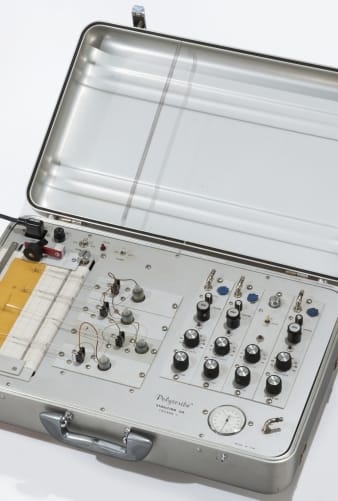

Detection
Artifacts from this Connect 3
Radiation, Inc. RF Receiver, Type UKR-1, circa 1951
Artifact
Transceiver
Date Made
circa 1951
Summary
Telemetry systems collect and display instrument information from remote and often hazardous locations. Rocketry, underwater exploration, and tracking of wild animals are just some of the fields that depend upon radio telemetry. These particular units were used to collect data during Operation Teapot, a series of nuclear detonation tests undertaken by the United States in 1955 in Nevada.
Creators
Place of Creation
Object ID
73.17.1
Credit
From the Collections of The Henry Ford. Gift of Dr. Lawrence L. Rauch.
Location
Not on exhibit to the public.
Get more details in Digital Collections at:
Radiation, Inc. RF Receiver, Type UKR-1, circa 1951
What is The Henry Ford?
The national attraction for discovering your ingenuity while exploring America’s spirit of innovation. There is always much to see and do at The Henry Ford.
Polyscribe Model 22770 Polygraph Machine and Accessories Kit, 1974-1977
Artifact
Polygraph
Date Made
1974-1977
Summary
Polygraphs are more popularly known as "lie detector" machines. They measure a person's pulse, breathing rate, perspiration, and blood pressure. Polygraphs convert this data into electronic signals; inking arms output this information onto paper charts. Trained examiners interpret the results, to determine guilt or innocence. The polygraph has been called out as unethical and legally inadmissible in some cases.
Creators
Place of Creation
Keywords
Object ID
2017.86.1
Credit
From the Collections of The Henry Ford. GIft of G. (Doc) Prudhomme.
Location
Not on exhibit to the public.
Get more details in Digital Collections at:
Polyscribe Model 22770 Polygraph Machine and Accessories Kit, 1974-1977
What is The Henry Ford?
The national attraction for discovering your ingenuity while exploring America’s spirit of innovation. There is always much to see and do at The Henry Ford.
Detective Camera, 1880-1890
Artifact
Camera (Photographic equipment)
Date Made
1880-1890
Summary
In 1885, Robert D. Gray created one of the earliest commercial spy cameras. It was designed for concealment: worn under a shirt, with the small lens protruding from a button hole. The spring shutter on the flat disc could be triggered with little suspicion. After each image was taken, the glass plate inside the disc rotated, producing small round photographs.
Place of Creation
Object ID
65.108.1
Credit
From the Collections of The Henry Ford.
Location
Not on exhibit to the public.
Get more details in Digital Collections at:
Detective Camera, 1880-1890
What is The Henry Ford?
The national attraction for discovering your ingenuity while exploring America’s spirit of innovation. There is always much to see and do at The Henry Ford.













